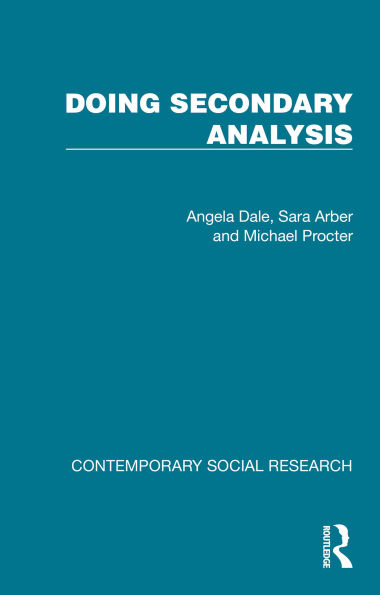Originally published in 1988 Doing Secondary Analysis is a practical guide to the secondary analysis of large-scale survey data.
At a time when funding for primary data collection was increasingly constrained, the secondary analysis of high-quality government surveys offered the social scientist an unrivalled opportunity. This volume provided a guide which moves through every stage of ‘doing secondary analysis’. The authors begin with the conceptualization of the research problem and examine all the practicalities of using both standard rectangular data and hierarchical data, and of deriving simple and complex variables. They also provide a lucid description of the hardware and software available to the secondary analyst at the time.
This book successfully demonstrates the way in which secondary analysis can contribute both to the development of sociological theory and to social policy formation. The authors emphasize throughout that secondary analysis cannot be used as a short cut to quick ‘results’, but that as much care over defining the research problem and understanding the categories of data is needed as for any other kind of research.
While Doing Secondary Analysis was invaluable to those about to embark upon social research, it also offered many challenges to more experienced researchers.
Originally published in 1988 Doing Secondary Analysis is a practical guide to the secondary analysis of large-scale survey data.
At a time when funding for primary data collection was increasingly constrained, the secondary analysis of high-quality government surveys offered the social scientist an unrivalled opportunity. This volume provided a guide which moves through every stage of ‘doing secondary analysis’. The authors begin with the conceptualization of the research problem and examine all the practicalities of using both standard rectangular data and hierarchical data, and of deriving simple and complex variables. They also provide a lucid description of the hardware and software available to the secondary analyst at the time.
This book successfully demonstrates the way in which secondary analysis can contribute both to the development of sociological theory and to social policy formation. The authors emphasize throughout that secondary analysis cannot be used as a short cut to quick ‘results’, but that as much care over defining the research problem and understanding the categories of data is needed as for any other kind of research.
While Doing Secondary Analysis was invaluable to those about to embark upon social research, it also offered many challenges to more experienced researchers.

Doing Secondary Analysis
258
Doing Secondary Analysis
258Related collections and offers

Product Details
| ISBN-13: | 9781040392942 |
|---|---|
| Publisher: | Taylor & Francis |
| Publication date: | 06/30/2025 |
| Series: | Contemporary Social Research |
| Sold by: | Barnes & Noble |
| Format: | eBook |
| Pages: | 258 |
| File size: | 7 MB |
